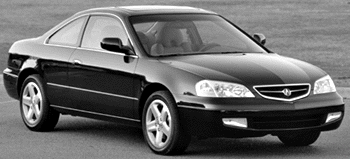![]()
Car
Lines
by Larry Mason
2001 Acura CL Type S
The all-new 2001 Acura CL Type S is larger, faster, and gets better mileage than its predecessor. What's not to like? Acura has done a great job of improving what was already a stylish and smooth riding performance sedan. Granted, the exterior styling of the new CL isn't quite as earth shattering as the last one was when it first came out, but it's what's under the hood that counts and this is where the Type S excels.
Unquestionably in my mind, the best attribute of the new CL Type S is the engine. Any time you can coax 29 mpg out of 260 horsepower, you've done a good job. Furthermore, the Type S cranks out 232 lb-ft of torque from 3,500-5,500 rpm. That's a Kansas flat torque curve provided for in part by the VTEC and dual-stage induction systems. Not only that, but that engine sound – it's like listening to a live orchestra of exotic metal instruments harmonizing to a 6,900-rpm crescendo. The wide power band gives the Type S good drivability in all traffic situations – similar to the legendary drivability of the parent company's Honda CART champ car engines. To get 35 more horsepower than the standard CL, Acura used a 10.5:1 vs. 9.8:1 compression ratio, larger throttle body, special intake valves, camshafts, and cylinder heads to name just a few of the changes.
The five-speed automatic "featuring the Formula 1 race car-inspired Sequential Sport Shift" is electronically controlled to prevent "gear-hunting" on up and downhill driving. It's also connected with the cruise control via electronics to automatically downshift during steep downhill segments so as to stay to the pre-set speed. As far as the sequential sport shift is concerned, I found it to be like most other cars with similar systems – more boy racer show than go. Although the push up or pull back sport shifter does allow you to shift approximately 10 percent quicker than in full automatic mode, it still takes 0.9 seconds to get the job done. That number is far from the millisecond reaction time of current Formula 1 cars. The only time I found myself using it for a legitimate driving reason other than just to have fun with was when I was in freeway traffic. I could be lazy and shift into a lower gear and utilize the engine braking instead of the four-wheel discs.
Handling prowess has been upgraded on the new CL thanks to the increase in torsional rigidity (6%) and bending rigidity (23%). The stiffer chassis combined with the front and rear subframes allow for better road noise and vibration isolation. The suspension is four-wheel independent with double wishbones, stabilizer bars and shock tower bar. The Type S adds firmer springs, shock valving and a larger rear bar to enhance its handling capabilities. The Type S handles very predictably and is fairly flat in the corners. It does seem to be a bit pitch sensitive though with noticeable brake dive and acceleration squat on initial application. The brakes take a bit to get used to, as they're a bit touchy to apply.
Spirited driving is what this car was built for, however if you find yourself caught in the moment of exhilaration of driving and find that you're approaching a corner a bit too fast, don't panic. Acura employs the Vehicle Stability Assist (VSA) system to help you make it to your final destination. The VSA system works in conjunction with the ABS and traction control systems to prevent you from spinning out. Not to say that it can't happen, but you're much less likely to find yourself facing the wrong way. The VSA system will individually adjust the braking force and traction control depending on lateral acceleration to minimize both understeer and oversteer. In practice, it works by slowing you down a bit but you'll find that if you pushed too hard into a corner, your turning radius will still increase over what you originally intended.
Step inside the Acura and you'll find numerous luxury accouterments. Starting with the eight-way leather power driver seat that has great lateral support, you'll be treated to the Acura Navigation System (ANS). The DVD based system has been programmed to provide over 3.7 million points of interest and maps the entire continental United States. The dashboard is simple and well laid out with tachometer, speedometer, and fuel/water temperature gauges reading from left to right. The Acura/Bose sound system is complemented by a six-disc in-dash CD changer with channel and volume controls on the steering wheel. Homelink, heated seats, auto dimming mirror, two-position seat memory, and reverse sensing passenger mirror (for parallel parking) are just a few of the other standard features. Rear ingress and egress is aided by the power walk-in feature of the front seats but you'll find the rear headroom lacking just a bit. Rear legroom however is quite ample. The only downside I found in the interior were the smallish vents for the climate control system which somewhat limited the airflow and the low frequency road noise that penetrated the cabin. If you want to get picky, the CL only has a trunk pass-through instead of split fold-down rear seats. I doubt that with all the other things this Acura has to offer, your purchase decision will be based on that.
Is it perfect? No. Is it close? Yes! I averaged 25.4 mpg in mostly highway driving so I would suggest that 29 mpg is not out of reach. Do you want to pamper yourself with performance, style, and comfort? If so, look no further than the new Acura CL Type S. At $32,785, you're getting a two-door sports coupe with power and luxury to spare. Take one for a test drive – but please, leave your driving gloves at home!
| The all-new Acura CL Type S comes standard with 260 horsepower and 29 mpg! | |
 |